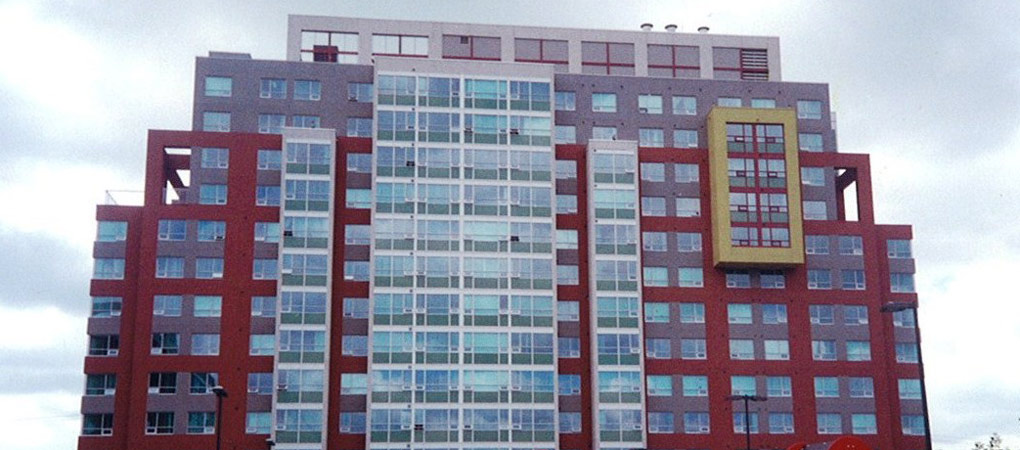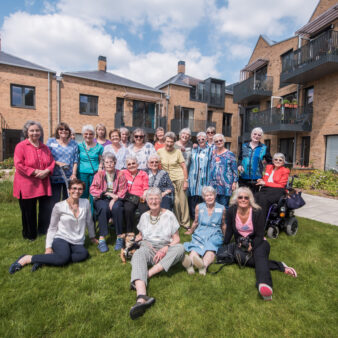The Tatry and Arbour Mill Non-Profit Housing Project in Canada is a 248 unit rental apartment complex in suburban Toronto. It was designed to provide affordable social housing, whilst at the same time creating a denser urban form in a sprawling suburban area as well as significantly reducing domestic energy consumption. It was initiated by two local community groups and provides high quality accommodation for a mix of income and ethnic groups. An innovative design and energy management system demonstrate how energy consumption and carbon dioxide emissions can be significantly reduced at little extra capital cost. Local community volunteers continue to be involved in the project, providing a range of social programmes with the residents.
Situated on the north shore of Lake Ontario, Toronto is the most southerly major Canadian city and is renowned for being the most cosmopolitan. Immigrants continue to be welcomed in the city and with ample space for its comparatively small population, the tendency is for urban settlements to sprawl over a large area. Although not as severe as in other parts of Canada, the climate can nevertheless be harsh, with long cold winters and hot humid summers.
The Tatry and Arbour Mill Non-Profit Housing Project is a 248-unit rental apartment complex built in Mississauga, a dormitory city of 500,000 people, 25 km to the west of downtown Toronto. The project was initiated in 1991 by two community groups. Tatry was sponsored by a Polish community-based organisation and Arbour Mills was a project of Pathway Non-Profit Housing Corporation, a service organisation formed by three church and synagogue groups in Mississauga. These two community groups are now the formal owners of the project.
The project consists of two buildings, one of seven stories and the other of thirteen stories, which are stepped down to blend with the lower rise dwellings nearby. It is built at comparatively high density on an unused site within the urban area, with retail facilities at street level. A one-storey underground car park is provided below the project. This brown field development sets a precedent for the implementation of an urban design program that will ultimately result in a denser urban environment in the sprawling city and encourage a lesser degree of dependence on the motor car.
The aims of this project were twofold; first, to provide affordable social housing; and second, to reduce energy consumption and costs and minimise the environmental impact of the project by implementing low energy designs and operations. The additional capital cost of improving the building envelope and installing energy efficient measures will be offset by savings on operating costs within seven to eight years. The project was initiated and built by a private developer, Windleigh Development Inc. The innovative design by the Toronto architectural firm, Quadrangle Architects Limited, has been commended both nationally and internationally and the success of the design is due in large measure to the high degree of co-operation amongst architects, engineers and developers from the early stages of the process.
High quality design and construction provide an attractive living environment, both externally and internally. For each block high quality communal facilities are provided, including a laundry, meeting rooms and a multi-purpose room. The buildings are built comparatively close to the street front, with easy access to public transportation and as a result, 50 per cent of the residents do not feel the need to run a car. 7,000 square feet of retail space was provided at street level as part of the project, which includes a chemist, food store, travel agent, dentist, a Polish deli and restaurant. The presence of these small shops encourage pedestrian traffic and reinforce the street front as a welcoming and sociable place to be.
The community groups still play an active role in supervising the day-to-day management, as well as helping run a range of programmes for and with the tenants. These programmes are funded and staffed primarily by volunteers and include a breakfast club which provides breakfast for school children if the parents have to leave early for work, help-with-homework schemes, craft clubs, public health programmes, food bulk purchasing groups and social events. The breakfast club has become so popular that a part time paid organiser is now employed to co-ordinate the work of the volunteers.
Within the property itself, much effort has been dedicated to creating areas for community use. The grounds are planted with trees and grass and both buildings have rooftop gardens, providing quiet outdoor areas for adults. Safe and attractive play areas have been provided for children, located so that the children can be easily supervised from the laundry and other communal rooms.
A two phase design strategy was used to ensure that the highest possible levels of energy efficiency were achieved. Allen Associates of Toronto was responsible for the design of the energy conservation strategy and the Green Catalyst Group consulted on implementation and policies. Firstly, the building envelope itself was designed to reduce the energy usage, and secondly, advanced methods of energy production for space heating and cooling, hot water heating and electricity were introduced. This double strategy enables the development to operate on 50 per cent less energy than a similar sized building built to current Canadian building standards. The key to reducing heat loss was the development of a tightly sealed building envelope with careful attention paid to air infiltration and ex-filtration through this envelope. The wall and roof insulation values were increased and window R-values doubled compared to conventional construction through the use of low energy argon filled double glazing with spectrally selective glass. The use of higher efficiency appliances and lights also helped to reduce energy consumption. The global effect of this project is to reduce carbon dioxide emissions to 30 per cent of what they would be under normal building standards.
Gas-fired co-generation plant placed on top of the taller of the two buildings supplies approximately 90 per cent of the space heating needs and all of the domestic water heating requirements. The two 60 kw natural gas co-generators provide nearly all the electricity required by the buildings and waste heat from producing electricity is, in turn, used to heat the water boilers. Summer air conditioning is provided to each apartment by running cold water through the two pipe system and creating air movement in suites with mechanical ventilation. The project thus demonstrates that even the strict Canadian energy saving standards can be substantially improved upon and considerable savings achieved, both in terms of energy and money.
A mix of income groups and ethnic groups is encouraged within the project, with 25 per cent of all apartments being let at market rent. The remaining 75 per cent are lower income households. Funding is by a mortgage guaranteed by the Province of Ontario Ministry of Housing and is repaid from rents. Provincial support is received by those tenants unable to support themselves. There is no difference in the design or size of those units occupied by those paying the market rent and those not. The rents are modest for the quality of accommodation. There have been very low levels of turnover and there is a long waiting list for people wishing to live there.
The Tatry and Arbour Mill Non-Profit Housing Project sets new standards, not only for high quality urban intensification but also for environmentally-conscious design. Such standards are widely applicable both in Canada and beyond.
Partnership
NGO, local government, local community



